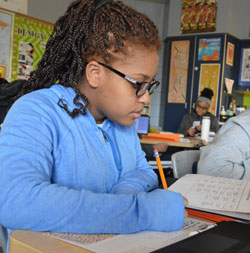Conflict. Leaving home. Starting over. Learning a new language. Going to school.
Valleywood Middle School students are embracing the stories of refugees and the people who own them.

In Jane Van Hof’s seventh grade English class — a portrait of diversity in itself– students are studying the stories of people forced to flee their native lands. For the project, dubbed “A Refugee Story,” they are delving into research on refugees and learning about those in their community.
Each student chose a country to study and created brochures including facts about history, language, culture, ethnicities and the conflicts that led people to flee their homes. They also included a call to action to help refugees in the community. Brochures — on display at the front entry of the school — aim to educate guests about the refugee experience.
Several students themselves are refugees, such as seventh grader Sen Dim, a soft-spoken girl from Myanmar (formerly Burma), who came to the U.S. in 2016 with her family after living for five years in Malaysia.
She said she doesn’t remember much about Myanmar, but knows her family had to learn a lot when they arrived. “We had to learn how to drive because we only used bikes in Malaysia,” she said.
“These kids are a shining example. These kids are here in the community, learning, and helping out.”
— Seventh grade English teacher Jane Van Hof
For the project, Sen created a brochure about a different country, Bhutan, where more than 100,000 Nepali-speaking Bhutanese wound up in refugee camps in eastern Nepal in the 1990s. The advice she gives for those welcoming refugees: “Be nice to them. Help them get around.”
Learning About the Journey
Students began the project by studying the war in Syria. They learned about Omran Daqneesh, a 5-year-old boy who was pulled from rubble in Aleppo, and watched a documentary about Syrian refugees arriving in Canada. They compared and contrasted refugee stories from three different countries, then chose a country on which to focus.
Students also practiced learning a made-up dialect,read the poem “Refugees” and studied The 42 Rights of a Child, as ratified by the United Nations in 1989 and the responsibilities of governments to ensure those rights.
Van Hof said the project is as much about research as reflection. “Being the most diverse school district in Michigan, what is our perspective on all of this?” she said. “They all have their own personal answers to that.”

The project connects with the culture of the schools. Students in that class alone come from at least 10 different countries. “These kids are a shining example. These kids are here in the community, learning, and helping out. All of their stories come together.”
Seventh grader Sifa Muleving chose to study Congo, where her parents are from. She was born in 2007, two years after they arrived in the U.S. as refugees. “My dad wanted us to move here to get a better education and get away from the war,” she said.
Her call to action is to welcome people. “Make them feel welcome. If you know a couple words in their language, say them. Invite them over to hang out.”
She said she loves the diversity in her school. “Not everyone is the same. You get to learn something about everybody.”
Alexandria Carillo-Gomez studied Colombia. Her grandmother and great grandparents came from Mexico. “A lot of people from different countries are suffering to find homes,” she said. “If a new kid from a different country comes, we should volunteer to make the kid feel special.”
Bradlieyh Ball, who studied Iran, said “It’s really good to learn about other children and how they felt, so if other refugees come to the school we can understand what they feel.”
And Cristian Martinez, whose parents came from Puerto Rico, said he learned what children face as refugees. “I feel like we should welcome them with open arms in America, be nice, respectful and kind, and give them shelter, clothes and food.”













